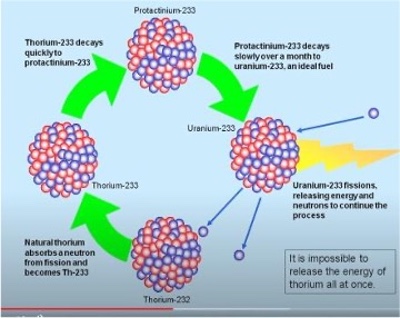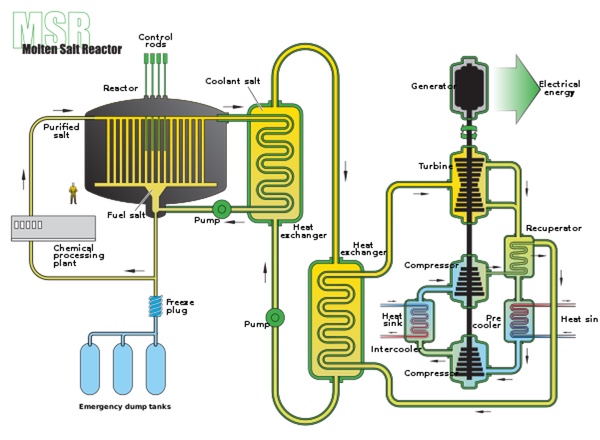Thor the lifesaver?by Ajay Kothari
|
| It may also have applications as a distributed power source on the lunar surface and later on Mars. Its potential application to rocket propulsion should also be determined. |
In addition to carbon dioxide, there is one threat faced by many poorer countries: pollution. Pollution in China and especially India is already shortening a healthy life for millions because of burning fossil fuels including lots of coal. It really is an awful situation right now. TMSR can go a long way to alleviate it. China just announced their intention to build 30 such reactors. However, India, with the largest reserve of almost a million tons, has not released any such plans, which is astounding and even appalling.
Unlike the Light Water Reactors (LWR), which the majority of reactors worldwide are, it will not require 200 to 300 atmospheres of pressure to keep the coolant water in liquid form. Instead, it will work at a couple of atmospheres. Thus, no high-pressure dome is needed, with its associated threat of malfunctions as we saw in Fukushima or Chernobyl. This is a huge positive.
The huge positive above comes with one negative factor. The temperature of liquid salt now is much higher, at 600 to 700 degrees Celsius. which would lead to corrosive impact on containment vessel. However, it also has some advantage in that the steam generation and electricity generation from turbines will be done at higher efficiency—almost 45%—unlike LWR ,where it is about half that.
If due to some unexpected circumstance, the temperature of the liquid goes higher than planned, the distance between nuclei increases, decreasing the impact of these thermal neutrons, thus decreasing the fission of U233. More on that later.
If that does not occur fast enough, a freeze valve installed at the bottom melts, flooding the containment tanks below, automatically cooling the fissionable fuel. Solidified TMS cannot not lead to fission. This also is a huge anti-accident insurance.
The lack of pressure containment needed, resulting in thick heavy structure for LWRs, also amounts to much lighter and smaller plants, thus making them portable. It may also lend itself to its use on rockets and airplanes, changing the paradigm compared to the 1960s when similar nuclear applications were last looked at.
MSRT will burn about 99% of thorium fuel into safe and even medically useful byproducts. This would mean even reducing the existing nuclear waste by more than 90%, some of which will form the seed for starting the initial neutron source.
Since this reaction requires neutrons to begin the process, what better way than to use up (albeit slowly) the residues left at places such as Yucca Mountain? Yes, it will also help to reduce this horrendously long half-life residues that we do not know what to do with. Now we may.
Admittedly there is one other disadvantage. Terrorists or adversaries could break in and break the freeze valve so all the ingredients would fall into the drain tank. However, the mixture would solidify at lower temperatures and become unworkable as a solid. There is also a poison pill. The U233 will contain trace amount of U232 with its accompanying gamma-ray radiation, enough to incapacitate the handler. To make a U233 bomb it would also have to be separated from the molten salt and enriched.
| This vision will solve the world’s energy problem a thousand times over (for thousands of years) with no carbon dioxide emissions during operation. |
We have been on this train before with U235 enrichment control and could do the same at that stage. We did not disallow countries to produce their own nuclear power. They do: 36 of them with almost 440 nuclear plants in operation worldwide. And whether we as a country move to realize this technology or not, many poorer countries will build them to get cheaper electricity for their populace, and hedge their bets against oil availability and reduction in air pollution. China has a large program to develop the TMSR technology and will likely overtake us in a few years. Our destiny could in that case be simply to be left behind here too just like possibly in cislunar space. We may need another Elon Musk, or many Kirk Sorensens, to take on the “Thor” insignia, but a better solution would be for the political class to wake up and the kneejerk anti-nuclear activists to at least see that their vehemence against these technologies is hurting millions of people of color, black and brown, worldwide through pollution.
 How thorium can be used to generate power. (credit: Credit: Kirk Sorensen, Flibe Energy) |
How does it work?
One of the forces that the physicists have long been trying to amalgamate in the Unified Field Theory of course is the strong nuclear force, enough to overcome the repellant electrostatic force of protons bound in a nucleus. This binding energy residing in a nucleus is the boon of nuclear power, in this case fission power. About 200.1 MeV of energy is released per atom of U233 upon fissioning. This is a million times greater per unit mass than chemical sources such as that produced by burning fossil fuel or coal.
A thorium atom, Th232, when bombarded by a neutron from some external source, absorbs that neutron producing Th233, thus increasing the atomic weight by one but not the atomic number. It being unstable, it transforms through beta decay to protactinium Pa233, more or less instantly, with half-life of 22 minutes. It further beta decays over 27 days to U233, which is fissionable. This atom fissions into strontium and cenon atoms releasing almost the same energy per atom as U235, 200.1 MeV.
How much do we need?
One ton of thorium is roughly equivalent to five million barrels of oil. Consequently, total thorium reserves, at about six million tons worldwide, are equivalent to 30 trillion barrels of oil reserves, whereas the total world reserves of oil are about 1.8 trillion barrels.
The world electrical need is about 55 billion gigajoules per year. This means 667 tons a year of thorium can meet this need. Considering efficiency of energy conversion, it may be two to three times this number, but with 6.3 million tons of thorium reserves worldwide, we have plenty to last several thousand years. With almost 600,000 tons of thorium reserve just in the US and our electrical energy need at about 21 billion gigajoules per year (or 666 one-GW plants), we ourselves have enough to last many hundreds of years, with zero import of oil or gas. Within that time frame it is patently plausible to assume that we would have solved the controlled fusion problem.
| We do not need to build tens of thousands of one-gigawatt SBSP plants in GEO, with their associated rectenna on Earth and ongoing maintenance calls in orbit. |
This vision will solve the world’s energy problem a thousand times over (for thousands of years) with no carbon dioxide emissions during operation. With the size and pressurization need substantially reduced, it may be the cheapest form of energy production for many of the poorer countries. It would not be fair to deny those countries a future.
Lunar LFTR?
Thorium has been also detected on the Moon by Chang’e 2. One kilogram of thorium taken from Earth to begin with can provide 2.6 thermal megawatts for a year. Imagine ten such plants in ten different locations with ten kilograms of thorium taken from Earth and the associated salt, which will eventually become self-sustaining with lunar thorium. Only the first such plant will require neutron-producing radioactive material to commence the chain reaction. The U233 thus produced can provide any further neutrons for additional reactors, thus becoming self-sustaining. For power on the lunar surface, however, this is only one of the promising options. Different locations may require different solutions, such as beamed power from SBSP.
For humanity on Earth, this solution is available today. We do not need to build tens of thousands of one-gigawatt SBSP plants in GEO, with their associated rectenna on Earth and ongoing maintenance calls in orbit! This solution needs to be developed right here in America. The time is now, for us, and for the rest of pollution-ridden countries to be availed of this technological marvel. One hopes this administration will pay attention to it and find a reasonable path for all of us. Soon.
Note: we are using a new commenting system, which may require you to create a new account.
